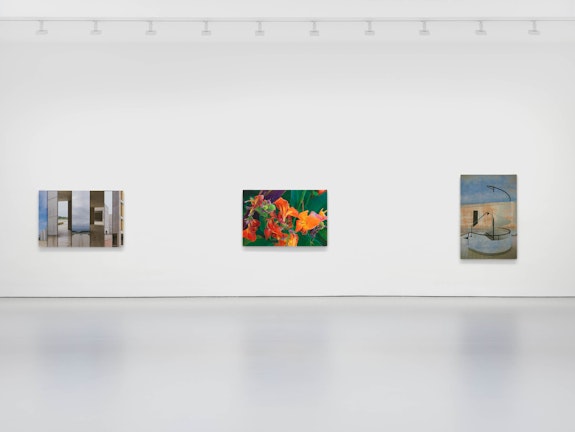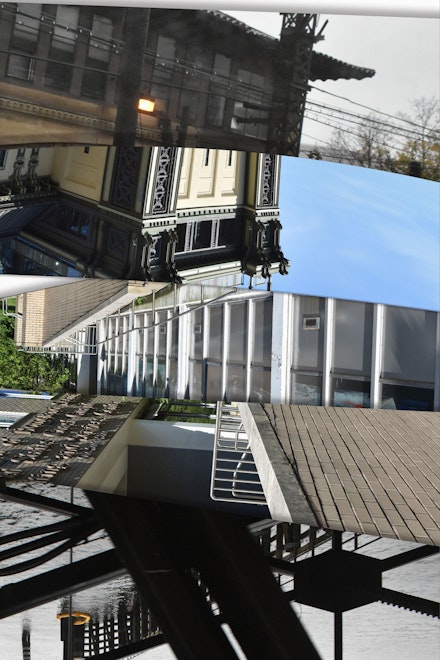ArtSeen
James Welling: Thought Objects

On View
David ZwirnerThought Objects
January 11–February 10, 2024
New York
The painter Elmer Bischoff used to hold his work to a simple standard. “What is most desired,” he wrote, “is a condition of form which dissolves all tangible facts into intangibles of feeling.” Bischoff, a leader of the influential Bay Area Figurative Movement, was a restless painter, ever searching for a new form. In the fifties, he turned away from Abstract Expressionism, finding success with a figuration long out of vogue, and by 1971, he was a prominent professor at Berkeley, sharing a studio with Richard Diebenkorn. About six hours south, James Welling was a new student at CalArts, similarly restless as a painter. He began to shift his practice, dipping his toes in dance, video art, and finally photography. The last one stuck: by 1976, Welling had left painting behind, working in watercolor only on days he couldn’t afford film. In the four decades since, Welling, who never once took a photo class, has built a storied career in the field.

But it’s not hard, gazing at the photographs Welling has assembled in Thought Objects, to picture their creator holding a paintbrush rather than a camera. The show’s standout work, Prouts Neck near Winslow Homer’s Studio (2015/2023), is a striking combination of seascape, lithographic overlay, and abstract coloration whose stippled, almost woody texture defies formal categorization. Closer in character to one of Gerhard Richter’s “overpainted” photographs than the austere monochrome compositions of Welling’s early career, the work conveys an impression and a feeling more than any literal image. In the equally painterly Hansaviertel Apartment Building (2017/2022), Welling assembles a geometric collage of colors with similar success. Like many of Welling’s works, this is an image borrowed from the digital and returned to the analog. As part of his lithographic process, Welling uses scrap newspapers to clean his rollers; in Hansaviertel, he has overlaid these leftovers to create a colorful palimpsest atop his subject. The resulting image is arresting, as much for how it looks as for what it accomplishes in affective terms. The blue-green contours of a window frame shroud a staircase, the afternoon light hanging in their wake. The tangible facts of a street scene dissolve into an impression of urban life.
It’s telling, perhaps, that Welling talks of “making” photographs, not “taking” them. The distinction speaks to his ambidextrous use of techniques and materials. Though Welling employs a digital camera, his process is decidedly tactile, a combination of time-honored methods of enlargement and offset, and the near-infinite possibilities of digital manipulation. Some of this practice reflects early personal experience: Welling’s father worked for a printing company, and from a young age, Welling learned about mechanical reproduction and separation. Now his best work mixes traditional technique and modern technology. His Glass House series (2006–2009, exhibited 2010) has an iridescent quality that seems at first glance the result of digital manipulation. But Welling conjured these colors the old-fashioned way, placing filters before his lens, painting the pigments of a scene before they touched his point and shoot’s tiny sensor.

Bischoff’s rubric ought to be particularly challenging for a photographer. There is no medium more closely associated with the literal, the objective, and the real (those “tangible facts”) than photography. And though this truthfulness may be an illusion, what Sontag called a false authority, the image’s impression of fact is unavoidable. It’s all the more remarkable, then, that Welling so regularly effaces the literal, extricating his images from the confines of reality as we typically perceive it. Works like Staircase, Villa Savoye (2020/2022) and Tea Pavilion (2017/2022) take full advantage of this flexibility, and they succeed by pulling off the same escape.
Often the contents of Welling’s scenes are less striking than his means of conveying them. His subjects are outgunned by the distinctiveness of his expression. This isn’t an uncommon phenomenon: “the ‘content’ of a medium,” Marshall McLuhan wrote in his 1964 landmark Understanding Media, “is like the juicy piece of meat carried by the burglar to distract the watchdog of the mind.” In Thought Objects, the medium is, if not the message, then certainly the source of emotive resonance. It’s Welling’s medium—something between photography, printmaking, painting, and collage—which satisfies Bischoff’s conditions of form. By stripping the straightforward facticity from his scenes, Welling produces images rich with the intangibles of feeling.
This effect is highly intentional: Bischoff, it turns out, wasn't the only one concerned with “feeling.” Welling’s works, the artist told Anthony Spira in 2012, have long endeavored to convey “the act of feeling.” Recently, the critic Alexander Bigman has connected this luminous phrase to Welling’s peers in the Pictures Generation, including the likes of Cindy Sherman and David Salle. But perhaps there are earlier Californian affinities. “Ideally,” Bischoff hoped, an artist should forget the “facts of things seen,” and “deal directly with the matter of feeling.” In Thought Objects, Welling has done just that.

